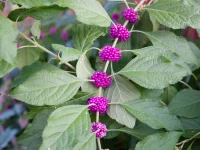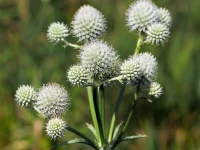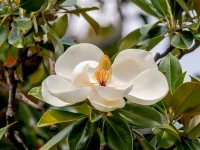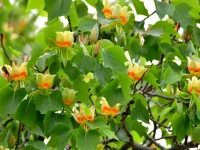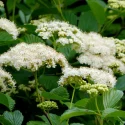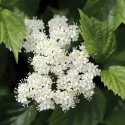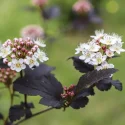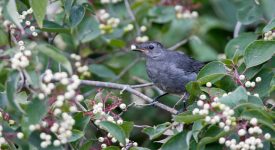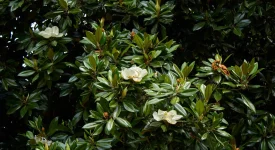Texas Mountain Laurel is an evergreen native shrub that sends out gorgeous fistfuls of purple flowers in the spring that attract pollinators (and people.) The smell of Texas Mountain Laurel flowers has been compared to grape Kool-Aid in several gardening books. They are easy to grow and, over time, can turn into small 20-foot trees.
Texas Mountain Laurel has been called “one of the ten best ornamental shrubs in the nation.” They are a stunning addition to any yard or park in the Southwestern United States. Find planting tips below.
- Full Sun, Part Sun
- Tall Shrub (11-15'), Small Tree (15-30')
- Spring flowers
- Pollinator lifeline
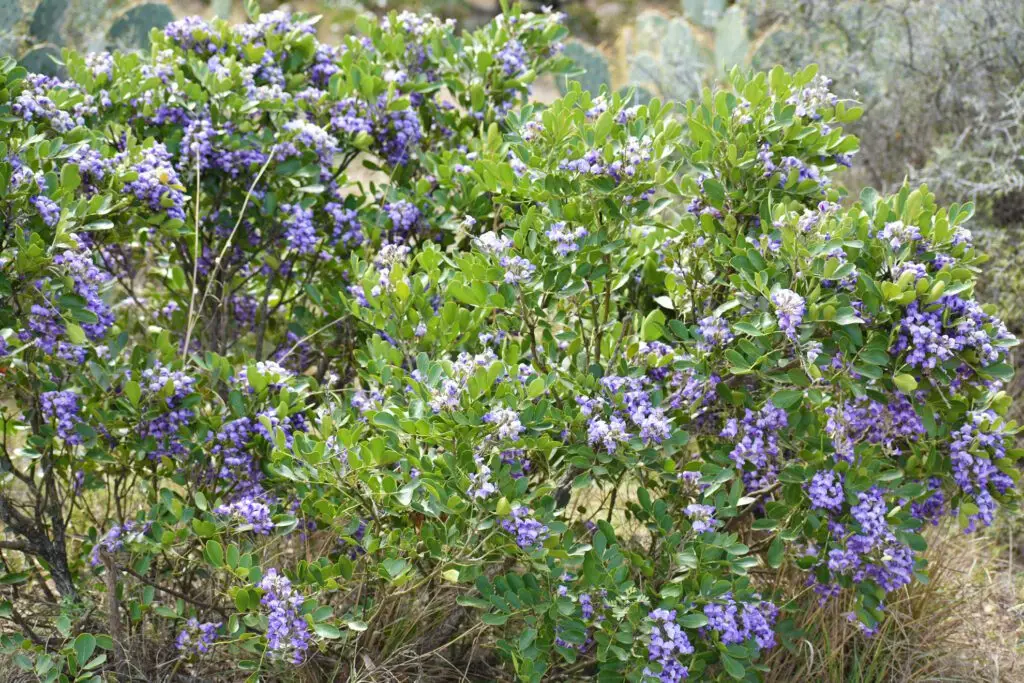
Dig Deeper
Explore the history, types, and where to plant native Texas Mountain Laurel
Table of Contents
Texas Mountain Laurel vs. *Mountain Laurel*
There are many species of mountain laurel native to America that roughly fall into either the “Texas Mountain Laurel” or “Mountain Laurel” group. (If you’re worried about which is which or looking for a specific plant, writing down the Latin name of the type you want will be a huge help. See below for their Latin names!)
Both Texas Mountain Laurel and Mountain Laurel:
- Look fantastic in highly visible spaces, like against houses or front gardens
- Are evergreen: their leaves are there, year-round
- Like a wide range of light—from full sun to part shade
- Perennials: they will come back year after year. Once you plant them and they are happily established, you can enjoy them in your yard for years to come.
- Low maintenance: no fertilizer or special needs are required for these plants to thrive
Types of native Mountain Laurel
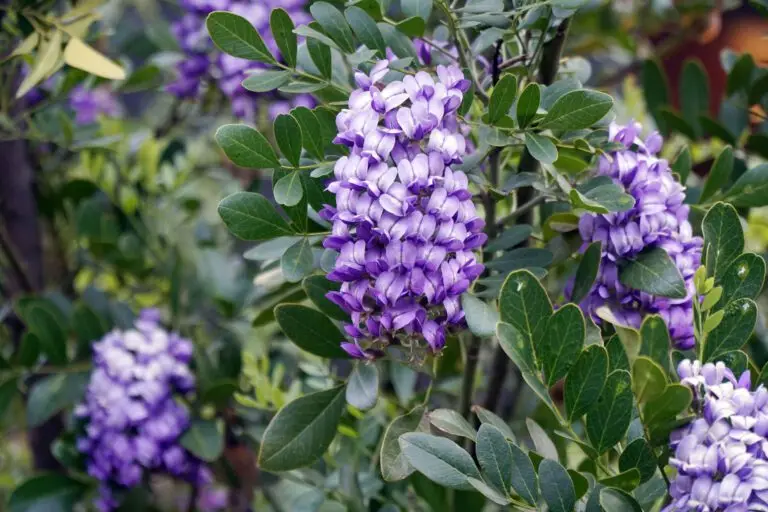
Texas Mountain Laurel
(Dermatophyllum secundiflorum)
Texas Mountain Laurel is native to Central Texas through to New Mexico. This species has flowers that smell glorious. Read on to find out how to plant Texas Mountain Laurel.
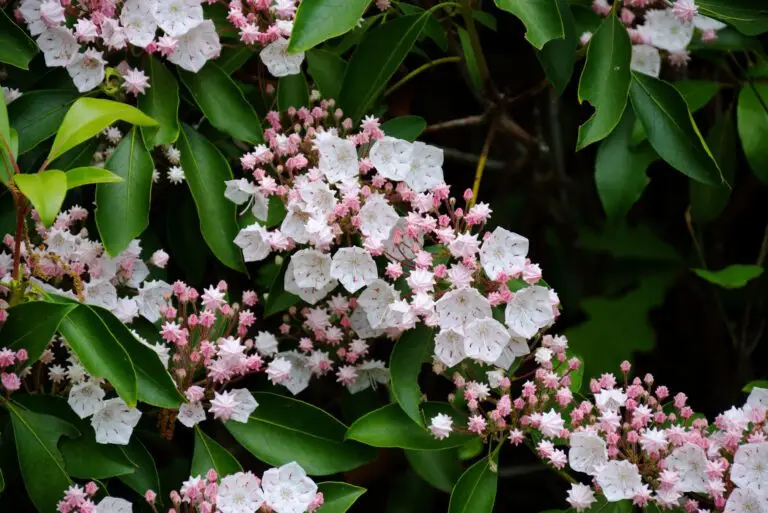
Mountain Laurel
(kalmia latifolia)
These species of Mountain Laurel are native to the Eastern US. Shrubs in this species group have tiny flowers shaped like algebraic equations. You’ll know you’ve got the right plant if the Latin name starts with Kalmia.
A history of loving Texas Mountain Laurel

It’s hard not to smile when reading native plant guru George O. Miller’s description of Texas Mountain Laurel:
“Many landscapers consider this plant one of the ten best ornamental shrubs in the nation. In March and April, showers of vibrant purple flowers cover the plant and perfume the air with the scent of grape Kool-Aid. Its compact, upright shape and the striking contrast between the deep purple flowers and shiny green leaves make it eye-catching as either a specimen or a component of a mixed planting.
It colorfully accents a patio or pool decor, whether in a small landscape garden or a large planter. You can prune, but not shear, it into an informal foundation, border, or privacy hedge. Since it’s an understory tree in nature, it will grow in filtered shade, though not as fast. Extra water speeds its growth, while cool summers impede it…With time, mountain laurel develops into an ornate small tree.”
Who doesn’t want a gorgeous-smelling, purple Kool-aid flower bush? Plant a few immediately.

Texas Mountain Laurels can go from bush to small tree
You can prune a Texas Mountain Laurel over time to be more in the shape of a tree than a bush. It will still make its purple Kool-Aid flowers and remain evergreen, even as it gets tall. Texas Mountain Laurels grow up to two feet a year.
How to Grow Texas Mountain Laurel
These shrub/trees are normally an understory tree; or a shrub that grows beneath taller trees. Because of their understory lifestyle, they are comfortable in a variety of light locations, from full sun to part sun (or partial shade.)
Texas Mountain Laurels are very easy to grow and take care of. They are:
- Drought-tolerant
- Evergreen: no matter the season, their leaves will be glossy and green
- Perennial: plant them once and they will come back year after year, for decades

A note on Texas Mountain Laurel seeds
Sadly, Texas Mountain Laurel seeds are poisonous. The seeds themselves reside inside a hard seed coat (it’s almost like a big peapod.) This hard seed coat helps give some protection from easily accessing the poisonous seeds found inside.
This native plant is best planted away from children and pets.
What to grow with Texas Mountain Laurel
Texas Mountain Laurel is fantastic alongside other heat-tolerant and drought-tolerant native flowers like coneflowers, milkweeds, and Rattlesnake Master, along with southern trees and shrubs like native azaleas and Southern Magnolia.
We also have lots of gardening guides to keep you inspired, from the Best Native Trees for Front Yards, Best Native Plants for Hummingbirds, and Best Native Plants for Birds. Or explore all the great natives flowers, shrubs, and trees for the South in our Southern Plant Guide.
In conclusion, the Texas Mountain Laurel is a unique and stunning plant that is a great addition to any landscape in Texas and beyond. With its fragrant purple flowers, evergreen foliage, and drought tolerance, it is a hardy and low-maintenance choice for homeowners and gardeners alike. If you are looking for a native plant that will thrive in a variety of settings, consider adding the Texas Mountain Laurel to your garden or landscape today. Happy planting!
Sources
- George O. Miller. “Landscaping with Native Plants of Texas“. (2006).
- George O. Miller. “Wildflowers of New Mexico“. (2020).
